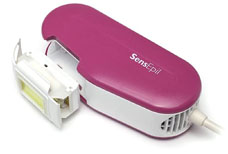About Laser Hair Removal
How Does Laser Hair Removal Work?
 Laser hair removal targets the destruction of the hair follicles, causing the hairs to fall off. Laser hair removal implies the use of laser light, which is of one single wavelength, but also includes the use of intense light of multiple wavelengths as in IPL – Intense Pulsed Light.
Laser hair removal targets the destruction of the hair follicles, causing the hairs to fall off. Laser hair removal implies the use of laser light, which is of one single wavelength, but also includes the use of intense light of multiple wavelengths as in IPL – Intense Pulsed Light.
A hair comprises the hair follicle, which supports the hair and its growth, and the hair shaft. The melanin pigment is present in both the hair and the skin, giving them color – the more melanin, the darker the skin and hair. Melanin is a chromophore, which is a molecule that can absorb light and convert the light energy into heat. The common chromophores in the skin are melanin, water, and oxyhemoglobin.
Laser hair removal involves the delivery of the laser or intense light to the melanin in the hair shaft, generating heat which is conducted down the hair shaft to damage or destroy the hair follicle, and thus the hair.
Does Laser Hair Removal Work for Different Hair or Skin Colors?
Since the laser light has to be absorbed selectively by the chromophore melanin in order to generate the heat needed to destroy the hair follicle, the lack of melanin in the hair shaft would not work for laser hair removal. Therefore, natural blonde and light color hair do not respond to laser hair removal.
By the same reasoning, dark skin color, naturally or by tanning, contains lots of melanin which absorbs light energy from the laser hair removal device to cause the heating up of the skin tissue and unintended injury. Therefore, laser hair removal does not work well for dark skin.
A simple illustration of the extremes is that laser hair removal would work best for a person with black hair and porcelain white skin, but poorly for one with light blonde hair and espresso dark skin.
The popularly used Fitzpatrick Skin Type further illustrates the use of skin color to assess the suitability of laser hair removal:

Type I – Porcelain white, always sunburns, never tans
Laser hair removal should be safe for the skin, but it might not be effective for naturally blond or light hair.

Type II – Beige/cream, usually sunburns, difficult to tan
Laser hair removal should be safe for the skin, and it would work better for the darker hair.

Type III – Light brown/ golden-hued, occasionally burns, slow tanning
Laser hair removal should be safe for the skin, and it would work better for the darker hair.

Type IV – Medium brown/caramel, rarely burns, tans easily
Laser hair removal should be safe for the skin, and it would work better for the darker hair which is usual for Type IV skin anyway.

Type V – Dark, rich brown, rarely burns, fast tanning
Laser hair removal might cause skin injury due to the heating of skin pigment Melanin by laser and is not advised.

Type VI – Espresso black, rarely burns, dark tanning
Laser hair removal might cause skin injury due to the heating of skin pigment Melanin by laser and is not advised.
Usually laser hair removal is not suitable for skin types V and VI. However, people with these skin types can consult with a physician to consider laser hair removal using the Nd:YAG laser, which is only available in a medical clinic setting.
Home Laser Removal Devices – Do They Work?
Laser hair removal started in medical clinics and spas, but it has gained popularity as a home use device. After meeting the safety and effectiveness requirements, the FDA in the U.S. has approved two home laser hair removal devices. The important FDA safety requirements address the elimination of skin damage and the laser danger to the eye from the use of the home laser hair removal devices, especially by over the enthusiastic consumer. On the other hand, the home laser hair removal devices must have enough power to provide effective results in hair removal to be done safely by the general consumer at home.
The two FDA approved devices are the Tria – Diode laser of 810 nm wavelength and Silk’n – Intense pulse light IPL of 475 to1200 nm wavelength spectrum.
Tria Laser
 A battery-powered, handheld laser device of 810 nm wavelength.
A battery-powered, handheld laser device of 810 nm wavelength.
Safety: Eye-safety technology obviates the need for protective eyewear during treatment. Should not be used for skin types V or VI.
Effectiveness: Wheeland 2007 reported mean hair reduction 1, 6, and 12 months after 3 treatments to be 60%, 41% and 33%, respectively. Transient skin redness was the only side effect. The subjects were skin types I to IV.
Silk’n – SensEpil
 Hand held Intense Pulse Light IPL device with wavelength spectrum of 475 to 1200 nm.
Hand held Intense Pulse Light IPL device with wavelength spectrum of 475 to 1200 nm.
Safety: Sensor built into the device so it will not flash with skin types V or VI.
Effectiveness: Mulholland 2009 reported after three treatments, the average hair reduction was 64% in 95% of patients in a three month follow-up. Alster 2009 reported a 40.4%- 61% hair reduction after three treatments with also a three month follow-up.
References:
Alster T.S., et al: Effect of a novel low-energy pulsed-light device for home-use hair removal. Dermatologic Surgery 2009 35:483-489.
Mulholland R.S.: Silk’n – a novel device using Home Pulsed Light for hair removal at home. Journal of Cosmetic Laser Therapy 2009 11:106-109.
Wheeland R.G.: Simulated consumer use of a battery-powered, hand-held, portable diode laser(810 nm) for hair removal: A safety, efficacy and ease-of-use study. Laser Surgery & Medicine 2007 39:476-493.
Recent Comments